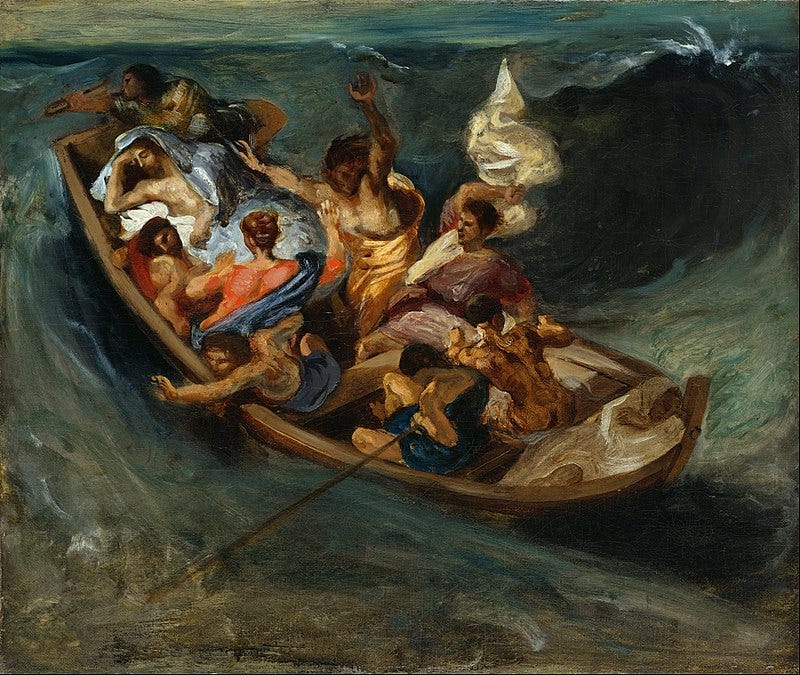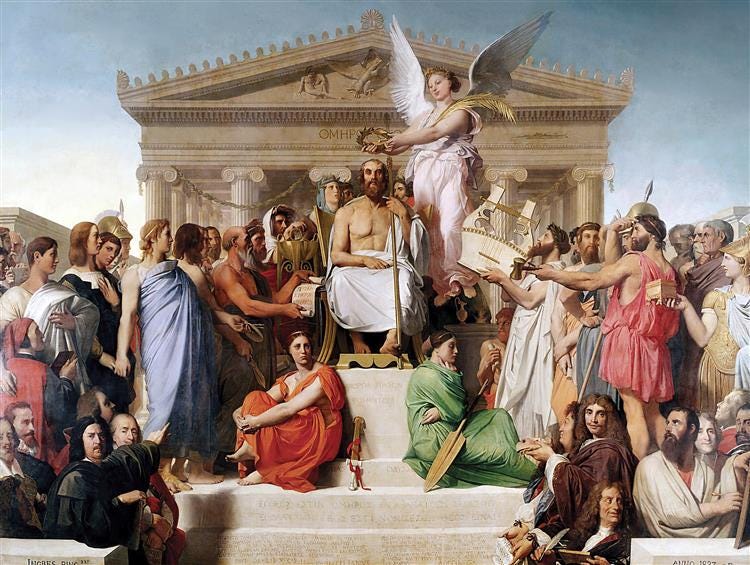In the early to mid 1800s, France played host to one of the greatest rivalries the art world had seen since the days when Michelangelo Buonarotti was working in Florence at the same time as Leonardo da Vinci.
On one side, was Jean-August-Dominque Ingres . . . the former student of legendary artist Jacques Louis David, who had since gone on to eclipse even the talent of his own master, and was now widely regarded as the greatest “Neoclassical” painter of the era.
While on the other side, there was Eugene Delacroix. The fiery, energetic leader of French Romanticism (and eighteen years younger than Ingres) who had ambitions of completely revolutionising the “archaic” traditions that his neoclassical rivals seemed to hold so dear.
_
Two very different men.
Two very different artistic ideals.
And of course, the 19th century art world was not big enough for both of them!
Ingres believed in a soft, methodical approach to art; creating works where every last detail seems to have been given equal care and attention.
This is seen to remarkable effect across his paintings - where idealized figures are often dressed in astonishingly well painted clothing.
But in fact, the simple medium of drawing was always the one Ingres claimed as most important for an artist - and the great man himself once said that he was considering renaming his own studio as “a school of drawing” . . . because he was convinced that if an artist were to spend 25 years learning how to draw properly, the ability to paint would also come along as a natural by-product.

In contrast -Eugene Delacroix’s approach to art was much more “heart first” .
Of course, he had all grown up with all the same admiration of Renaissance and classical ideals as his older rival. And yes, he did seek accuracy and realism just as any painter of the era would have.
But, even more than that, Delacroix wanted his work to have a forcefulness. And an emotional power. And a sense of spontaneous energy.
Like a musician playing freestyle rather than spending years carefully composing what they wanted to play . . . Delacroix believed that art should capture a moment that is still unfolding (something which can indeed be lost when a work is too highly posed or “overworked”)

Thus, when asked to give his opinion on the highly finished masterpieces by Jean Ingres - Delacroix would certainly not hold his punches.
He claimed his rival’s work was “ridiculous” and “pompous” - with “not a single spark of the natural!”
And when it came to the art of drawing (which, of course, was where Ingres arguably excelled the most) - Delacroix once again honed in on the sense of “effort and pretension” of his great rival, saying:
“If an artist does not have sufficient skill to make a sketch of a man throwing himself out of a window in the time it take him to fall from the fourth floor to the ground . . . then, sadly, that artist will never be capable of great work”
But, make no mistake, the words of criticism were certainly not a one way assault here.
Ingres’ style of painting may give the impression of him being a graceful and soft character - yet, by all accounts, he has just as much fire as Delacroix too. And was certainly never a man to suffer fools gladly.
In fact, Ingres is known to have referred to Delacroix as “The apostle of Ugliness” and “a dangerous character”.
And there is even a rumour of the men getting into such a heated debate at a party once, that Ingres ended up throwing a cup of coffee over his younger rival.
Yet as is so often the case with this kind of rivalry - underneath the war of words, there is no doubt that two men would surely have recognised the talent of the other.
After all, it is not by accident that they so often ran into each other at exhibitions . . . or found their work hanging on the same walls at the prestigious Paris Salon.
And thankfully, towards their latter years, it seems that the two men did learn to be more civil - or, at least, to accept that there really was room enough in the art world for both Neoclassicism and Romanticism.
Eugene Delacroix eventually passed away in 1863, aged 65.
And Jean Ingres died only four years later, having made it to an impressive 86.
But a few years prior this, in around 1860, one of Ingres’ own pupils recorded the last known meeting between these two titans of French art.
It happened by sheer accident - with the two men bumping into each other quite by chance on the steps of the French institute. Only, this time, there was no debate . . . no criticism . . . and no throwing of coffee.
Rather, the two artists simply stopped for a moment - shook hands respectfully - and then, with a few last words that none of us will ever know, went their separate ways again.
_
Two very different men.
Two very different artistic ideals.
But a fitting moment of truce!










Does it make you as sad as it does me that there was a time that art meant so much, not just to those titans of painting, but to the world at large?
I’m delighted to support your effort, George. My day is given a delightful and instructive sendoff each morning as I study your post! Thanks and keep it going and growing.😎